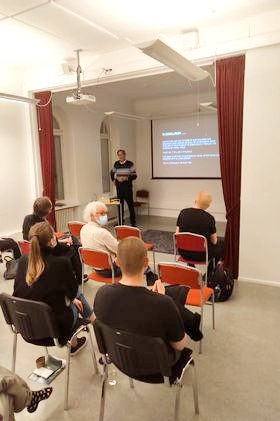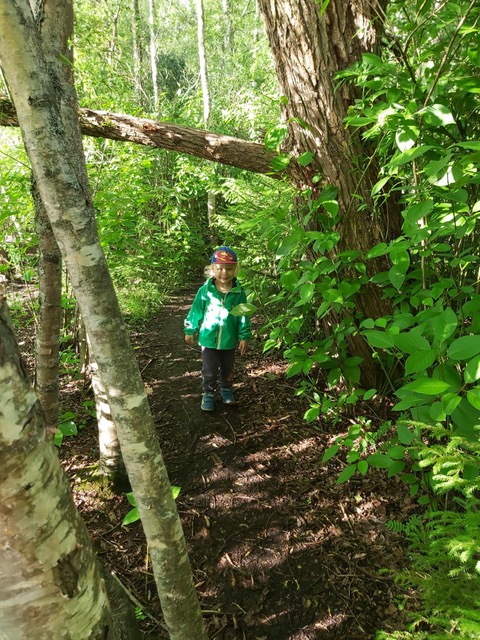By David Rogers, Finnbrit member

On Sunday, October 11, I gave a presentation about the threats and opportunities inherent in the climate crisis at the Finnbrit Language Centre. The talk began with my own personal reasons for becoming a climate activist.
My story begins with a confession that I haven’t always been as environmentally conscientious as I am today. Believe it or not, after graduating as a Chemical Engineer, my first job was in a smokestack industry! Alcan Aluminium’s Jonquière, Quebec smelter in Canada was my workplace for four years.
As you can see from this photo of the smelter, pollution poured out of the smokestacks and there were carbon particles in the air. So, what changed between that time and the present to turn me into a climate activist?

Inspiring and sometimes shocking documentaries like Al Gore’s “An Inconvenient Truth”, Leonardo di Caprio’s “After the Flood” and Sir David Attenborough’s “A Life on Our Planet” certainly influenced my thinking.
News stories about wildfires in Australia, Siberia and California, severe flooding in France and southern Asia, increasingly strong and frequent hurricanes and cyclones and mammoth chunks of polar ice crashing into the sea also caught my attention.
After my retirement earlier this year, there was more time to reflect on the major challenges facing the world. It became clear to me that the climate crisis is by far the greatest threat to humans and other species which share our planet. This is so because it has the potential to drastically alter the lives of hundreds of millions if not billions of people. That realization caused me to think that maybe it was time to get off the sofa and actually do something about this dangerous climate crisis.

However, what really tipped me over the edge into climate activism was my three granddaughters who live in Toronto and are pictured here. I began to think how their lives could be drastically changed as young and middle-aged women if nothing or not enough is done now to curb the rapidly increasing emissions of global warming pollution.

Another person whose life could be dramatically affected by 2040 or even before is my partner Päivi’s three year-old grandson, who is seen in this photo walking in a Finnish forest, something he loves to do.
These young people motivated me to register for Al Gore’s Climate Reality Leadership training which was completed in early September. Al Gore’s enthusiasm proved to be contagious and I made my first ever public presentation about the climate crisis on October 11.
The technology already exists to allow a significant reduction in the burning of fossil fuels. Investments in both wind and solar electricity generating capacity have increased exponentially since the year 2000. In fact, it is now less expensive to produce power using solar and wind sources than by burning fossil fuels like coal, natural gas or peat. Therefore, there is no longer any valid reason to keep fossil-fuel fired power plants in operation.
The sun doesn’t always shine and the wind is sometimes calmer. For this reason, it’s important to have the capacity to store energy generated on sunny and windy days. This can be done with storage batteries such as the ones used to back up wind and solar generating units in the state of South Australia. Storage batteries are also used by some of the world’s largest electric utilities like Florida Power and Light and Pacific Gas and Electric, to store energy produced from renewable sources.
The production, installation and maintenance of wind and solar power generating facilities has created thousands of jobs around the world and will continue to do so as these sources of energy become more widely adopted. Even those previously sceptical about climate change such as Boris Johnson now want to join the party. He promised earlier this month to supply electricity to all British homes by 2030 using power generated by offshore wind turbines.
Clearly, the means already exist to replace the burning of fossil fuels with renewable sources of energy like wind and solar. In my opinion, nuclear energy must also be used as an energy source. Like air travel, the nuclear industry has an excellent overall safety record. Nuclear reactors emit no carbon dioxide and are therefore an ideal replacement for fossil fuel-fired power plants.
Although more people are now talking about the climate crisis and the issue has attracted greater media attention, there is no real sense of urgency on the part of some politicians. Many talk about achieving net carbon neutrality by 2050. in my opinion, 2050 is far too late. A few progressive national leaders like Sanna Marin in Finland and Jacinda Ardern of New Zealand have set more ambitious goals. Both countries plan to achieve net carbon neutrality by 2035 with significant progress toward that objective by 2030. Hopefully, other countries will follow their lead over the next five years.
After the CoVid crisis abates, there will be significant pressure from vested interests like the fossil fuel industries and some political parties to return to business as usual. This temptation must be resisted with all our energy if we are to chart a new, more sustainable course toward a better future for our children and grandchildren. It will not be an easy struggle but it’s one which must be won. I’m up for this fight and fervently hope that you are too.
